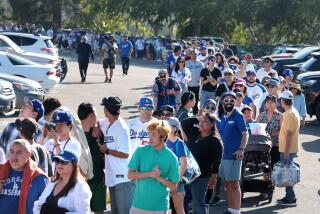Column: Jim Ballard outlived his love for the Dodgers, but not the greed that took them from him
He spent the last three years as a symbol of what has become the biggest Dodgers ownership blunder in franchise history.
Jim Ballard was featured in this column in April 2015 as a World War II veteran frustrated over losing a nightly battle to watch his long-cherished Dodgers.
“I feel so helpless,’’ said the then-93-year-old Carpinteria man. “It’s like my team just forgot all about me.’’
Like residents of the majority of Southern California homes, Ballard lived in a house where the Dodgers did not appear on television. Charter Spectrum, the only pay-TV provider that carries the Dodgers’ SportsNet LA channel, was not available in his area, and Ballard was neither inclined nor equipped to pirate the games.
So for four long years, he cursed the owners of his beloved franchise while constantly searching the TV listings for hope that he could once again see the Dodgers play on a regular basis.
Turns out, that hope never came. The Dodgers’ blackout outlived him. On Feb. 21 at 9:30 a.m., upon suffering a massive stroke while going for his daily walk, Jim Ballard died at 97.
He died wearing a Seattle Seahawks T-shirt. He had Dodgers shirts, but they remained in the closest as forgotten souvenirs of a lost love.
“It got to the point where it didn’t mean that much,’’ said John McCoy, his grandson and caretaker. “It was just a shirt.’’
He died with his final memories of the Dodgers wrapped around an odd postseason where he felt like he was cheering for strangers. He watched last autumn’s World Series run on national TV, but wasn’t always sure who he was watching.
“It was hard for him because he really didn’t know the players,’’ McCoy said. “He had no idea about Cody Bellinger, he had only read about Corey Seager, he didn’t recognize Yu Darvish. After all these years, you just get out of the loop, and your connection to the team slowly dies.’’
Even until the end, Ballard had faith that the Dodgers would come to their senses, lower the price for pay-TV providers, and give up some of their riches to allow their channel to be seen by everyone.
“We honestly thought they would get back on TV before he died,’’ McCoy said. “There was so much outrage from everyone. He kept checking those listings.”
Yet in a final twist of the knife, two days after Ballard’s death it was announced that the blackout would continue for a fifth consecutive season.
“Other distributors are not expected to carry SportsNet LA this season,’’ Spectrum said in a statement, meaning there is still no agreement with DirecTV or other local cable and satellite providers.
The same announcement contained news that five games will be shown on KTLA (Channel 5) in March and April. That’s five out of 162 games, or about 3% of the action. How generous.
“My grandfather could never understand why he couldn’t just turn on the TV and the Dodgers would appear,’’ McCoy said. “I’m not mad, I’m just disappointed that no one could come together to fix this. There’s so much money involved, why do the Dodgers have to do this to their fans?’’
The money, as has been chronicled for years, is the root of this problem. It began in the 2014 season after the new Dodgers ownership reached a deal with Time Warner Cable that would pay the team $8.35 billion over 25 years in exchange for exclusive marketing rights for the new channel. In hopes of recouping their huge investment, TWC and, later, Charter Communications set a price that local pay-TV providers, namely DirecTV, found unacceptable.
Thus, the stalemate, which led to the blackout and eventually an alienation with the community that even the presence of late-October baseball cannot repair.
Guggenheim Baseball Management has used its billions of dollars to splendidly refurbish Dodger Stadium and smartly field a rich and successful team. Yet the legacies of team chairman Mark Walter and president Stan Kasten will be inexorably linked to the blackout, because the majority of Los Angeles does not attend the games, and those fans cannot connect with what they cannot see.
“To me, my grandfather epitomized the true Dodgers fan who cannot watch the Dodgers,’’ McCoy said. “His interest slowly decreased, from a month to two months to a year, before it finally just died out.’’
There are no statistics to measure the loss of affection from folks like Jim Ballard. But the effect of four dark years on a team’s branding is clearly visible. This should be the Dodgers’ chance to steal the town back from the losing Lakers, but, with the SportsNet LA TV ratings ranking among the bottom five in all of baseball, they keep losing ground.
How many folks around town do you see wearing the jersey of an untested rookie named Lonzo Ball? OK, how many are dressed in the jersey of future Hall of Famer Clayton Kershaw? Folks are always buzzing about watching a Lakers game, but does anybody ever talk about watching a Dodgers game? Ever? It’s almost like the few who do get the Dodgers — an astonishingly low 79,000 by one count last midseason — don’t want to gloat.
In one sense, the Dodgers are winning this battle, because they are keeping their money while wearing people down. The appetite for outrage appears to be waning.
“I think everybody is kind of saying, ‘Well, this is what’s happening now, and there’s nothing we can do about it,’’’ McCoy said. “I think people have given up. It’s not on their minds anymore, because it’s a losing effort.’’
But on the other hand, well, there is Jim Ballard, a Bronze Star war hero who planned the final years of his life around watching a team he had devoutly followed for almost 60 years, scheduling every summer night for a date with his burgundy recliner, a bottle of Arrowhead spring water and a can of Planters cocktail peanuts.
Somebody’s greed took that away from him forever. The outrage must live on.
Get more of Bill Plaschke’s work and follow him on Twitter @BillPlaschke
More to Read
Go beyond the scoreboard
Get the latest on L.A.'s teams in the daily Sports Report newsletter.
You may occasionally receive promotional content from the Los Angeles Times.











